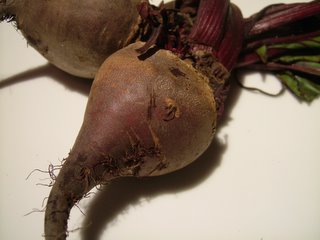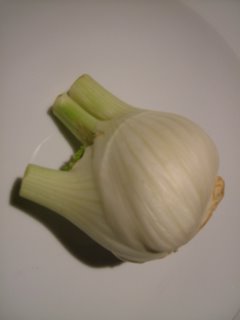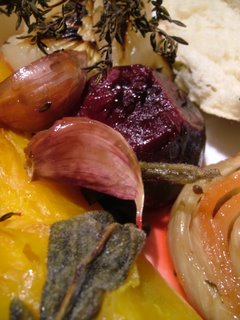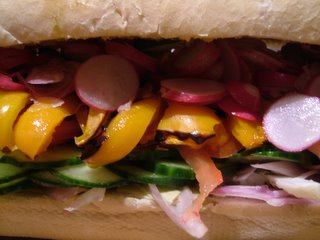 I’ve just bought a new mandoline, having noticed that I was avoiding cooking as much gratin as I would like in order to avoid the slicing. Unfortunately, you’ve already read my very best gratin recipe, so I put my mind to other dishes which might involve a lot of delicate slicing of hard vegetables.
I’ve just bought a new mandoline, having noticed that I was avoiding cooking as much gratin as I would like in order to avoid the slicing. Unfortunately, you’ve already read my very best gratin recipe, so I put my mind to other dishes which might involve a lot of delicate slicing of hard vegetables.
Pan Bagna is Provençale for Big, Wet Sandwich (actually bathed bread, but Big Wet Sandwich is more descriptive). It’s big, it’s wet, and it’s full of delicate slices of sunshine; olives, garlic, peppers, artichoke hearts and all the best bits of Provence.
You’ve spent years trying to stop the tomatoes in your sandwich making the bread wet. This is a recipe where you want them to make the bread wet. You want the bread drenched in olive oil, tomato, the golden liquid running off freshly roast peppers, the scent of garlic and savoury juices.
You can make this without a mandoline, but the slicing will take you longer. Make your pan bagna the night before you plan to eat it so that the flavours can mingle and the bread soften. To feed three people (or two obnoxiously overweight ones) you’ll need:
1 large loaf of good, rustic bread
½ a cucumber
8 tomatoes
12 radishes
6 artichoke hearts in olive oil
8 anchovy fillets in olive oil
2 shallots or 1 small red onion
2 red or yellow peppers
8 black olives
2 teaspoons of capers
2 cloves of garlic
Pepper
Olive oil
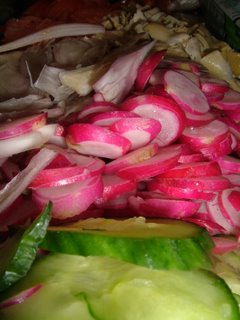 Quarter the peppers, put them in a dry frying pan until charred, and slice into strips. Slice
Quarter the peppers, put them in a dry frying pan until charred, and slice into strips. Slice
the loaf (I used a baguette-shaped one – round loaves work well too) in half along its equator. Pour olive oil all over each of the cut sides of the bread, and rub it in with the back of a spoon. Spread a crushed clove of garlic on each of the cut sides – the oil will help it spread evenly.
The oil-pouring stage was the stage at which Raffles the cat decided to do some kitchen-based leaping. He ended up with an Ayurvedic-style stream of olive oil running onto the top of his head, and now looks like an advertisement for cat Brylcreem. It appears to be hard to lick the top of your own head, so we are hoping his sister notices and helps him out.
Lay the oily, garlicky bottom slice on a piece of clingfilm large enough to wrap around a very big sandwich. Slice all the vegetables thinly, and build up layers on the bottom slice of bread. (There’s no set order to do things in here, so you can use your imagination.) This may require some engineering skill; this is a lot to fit into one baguette, and you may find it helpful to chock the slice of loaf with teaspoons to keep it level. Make sure the anchovies (chop them), olives and capers end up in layers towards the middle so their flavour can permeate the whole sandwich.
Anchovy-haters are allowed to substitute tuna.
When your sandwich is full of all the ingredients, put the lid on and wrap tightly in cling film. This is a two-person job. When you’ve got a cling-film cocoon, wrap that in tin foil. Then put the whole thing in the fridge, with weights on the top.
MFK Fisher advocated sitting on your sandwich over an afternoon or so. Feel free to do this if you do not care particularly for your soft furnishings. Otherwise, leave the sandwich, weighted, in the fridge overnight, unwrap carefully, slice and serve. Have a good munch in the snow and pretend you’re in Nice.


